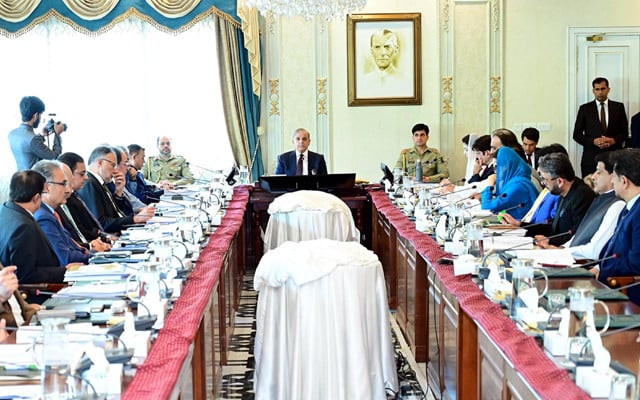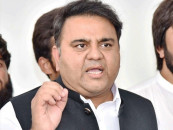Budget 2024-25: NEC approves Rs3.5 trillion development budget
Rs932 billion or 27% of the total national outlay will be funded by taking foreign loans

The National Economic Council on Monday approved one-fourth higher national development budget outlay of Rs3.5 trillion amid support by the four provinces, including Khyber-Pakhtunkhwa, for the International Monetary Fund (IMF) programme.
In a baby step towards federal fiscalism and consensus decisions on major national economic matters, Prime Minister Shehbaz Sharif also set up a committee under his trustworthy Economic Affairs Minister Ahad Cheema to prepare a mechanism under the NEC to involve provinces in major decisions.
However, the NEC revived the budget for the parliamentarians’ schemes and allocated Rs75 billion for the next fiscal year in addition to setting aside more financial resources for provincial nature projects in the federal budget 2024-25.
These decisions were in contradiction to the decisions made by the NEC in January this year when the parliamentarians schemes had been discontinued and the provincial nature new projects were banned from the federal Public Sector Development Programme (PSDP).
Headed by Prime Minister Shehbaz Sharif, the NEC – the constitutional body mandated to approve the nation's financial policies, also endorsed next fiscal year’s economic growth rate target of 3.6% and the inflation target at 12%. The NEC approved a five-year macroeconomic plan including a target to increase the country’s exports of goods and services to $63 billion by 2029.
Some members objected to projecting negative growth in the important crops in next year including in wheat and rice. But subsequently the NEC approved the annual plan after Deputy Prime Minister Ishaq Dar urged the forum to approve these numbers subject to the condition that these would be again reviewed by the NEC.
The NEC approved a Rs3.5 trillion budget for the federal and four provincial governments – a sum that is Rs663 billion or 24% higher than the original allocations for the outgoing fiscal year. Out of the Rs3.5 trillion, an amount of Rs932 billion or 27% of the total national outlay will be funded by taking foreign loans.
Read more: SBP cuts interest rate for first time in four years amid inflation slowdown
The NEC approved Rs1.4 trillion worth federal PSDP, which is higher by Rs450 billion or 47% over this fiscal year’s budget. The federal government has estimated receiving Rs316 billion worth project loans in the next fiscal year to finance its bloated development programme. Earlier, the Finance Ministry had indicated Rs1.5 trillion PSDP, which it cut by Rs100 billion.
Four provincial chief ministers attended the NEC meeting and assured Prime Minister Shehbaz Sharif of their support for the IMF bailout package, including providing the cash surpluses equal to 1% of the GDP, a federal minister told The Express Tribune.
The provincial governments also assured their support for the National Fiscal Pact, which the IMF is asking Pakistan to implement as part of the conditions for the next programme.
As per the IMF condition, the National Fiscal Pact has to be concluded by end September and the deadline can only be achieved if the Finance Ministry sits with the provinces, said Muzammil Aslam, the Advisor to CM KP on Finance.
Under the National Finance Pact, the province will share spending on the Benazir Income Support Programme, Higher Education Commission and provincial infrastructure projects.
The provincial governments would also have to throw a Rs1.219 trillion cash surplus for the next budget under the IMF condition. Punjab’s share is Rs630 billion, Sindh Rs300 billion, Khyber-Pakhtunkhwa Rs178 billion and Balochistan’s share is Rs111 billion.
Finance Minister Muhammad Aurangzeb will formally announce the budget on Wednesday.
The NEC approved Rs2.1 trillion provincial annual development plans – higher by Rs216 billion or 12% over this year’s original budgetary allocations. The four provincial governments would take Rs616 billion worth foreign loans to finance their schemes.
The government of Punjab’s next year’s development budget is indicated at Rs700 billion compared to original Rs655 billion for this year. Chief Minister Maryam Nawaz Sharif told the forum that her province’s budget may increase to Rs825 billion once the internal exercise is finished.
Sindh will spend Rs764 billion on development compared to Rs652 billion this year. K-P would spend Rs351 billion compared to Rs290 billion this year. Balochistan would spend Rs281 billion.
On the requests of the chief ministers of Sindh and Khyber-Pakhtunkhwa, the prime minister instructed the Planning Commission to include their schemes in the federal PSDP. Under the National Finance Commission, the provinces get 57.5% shares in revenues and yet the federal government has been taking the responsibility of many provincial nature schemes.
Read more: PM-led NEC meeting discusses investments and future plans
The NEC approved Rs260 billion allocation for the Water Resources Ministry – up by Rs150 billion over this year’s budget. The National Highway Authority’s budget is approved at Rs180 billion – higher by Rs25 billion over this year.
Similarly, the Power Division and the National Transmission and Dispatch Company will get Rs175 billion for the next fiscal year against this year’s Rs100 billion allocation. An amount of Rs75 billion has been given for the schemes recommended by the parliamentarians compared to original allocation of Rs90 billion in this fiscal year.
The Education Ministry’s budget has got a major boost and the NEC approved Rs32.8 billion allocation for the next fiscal year – up by 285%. Similarly, the Higher Education Commission’s budget has been increased to Rs66.3 billion – an addition of Rs4 billion over this year. Earlier, the Annual Plan Coordination Committee had cut the HEC budget to Rs21 billion.
The federal government increased the total allocations for projects of the provinces and special areas to Rs191 billion from last year’s Rs167 billion. The allocation should have been reduced to lower spending on provincial nature schemes but due to political expediency it has been further increased.
The Rs191 billion allocations include Rs53 billion for provincial projects, Rs63 billion for merged districts of Khyber-Pakhtunkhwa and Rs75 billion for Azad Kashmir and Gilgit-Baltistan governments. The allocations under all these three heads are higher than this fiscal year.
Pakistan’s economic conditions do not permit inclusion of provincial nature projects in the federal PSDP. However, the coalition government is dependent on other political parties to get the budget passed from the National Assembly. Deputy Prime Minister and Foreign Minister Ishaq Dar is negotiating with the provinces on behalf of the federal government.
An amount of Rs41 billion has been allocated for the Ministry of National Food Security and Research -360% higher than this fiscal year. The Ministry of Planning’s budget has been approved at Rs84 billion –also higher by 147% over this year’s original allocation.
The Ministry of Railways budget has been settled at Rs45 billion -36% higher than this fiscal year. The Suparco has been given a Rs36 billion budget compared to Rs10 billion in this fiscal year. The Ministry of Information Technology has been given a nearly Rs30 billion budget compared to just Rs6 billion in this fiscal year.
Macroeconomic framework
The NEC approved the five-year economic framework and fiscal year 2024-25 annual economic plan. The chief ministers of Punjab and Khyber-Pakhtunkhwa asked the Center to include them in the annual economic planning and implementation.
THE NEC approved the new fiscal year’s economic growth target of 3.6% -compared to 2.4% achieved this year. The agriculture sector growth target is set at 2%, industrial 4.4% and services at 4.1%.
Next fiscal year’s inflation target has been set at 12% compared to the 24% rate achieved this year.
For the next fiscal year, the current account deficit is projected at $3.7 billion or 0.9% of the GDP, compared to expected just $492 million this year.
The exports of goods are projected at $32.3 billion –compared to $30.3 billion in the current fiscal year. Similarly, imports are projected to be curtailed at $57.3 billion –as compared to expected $52.1 billion in the current fiscal year.
Workers Remittances have been projected at $30.3 billion as compared to $28.8 billion this year.



















COMMENTS
Comments are moderated and generally will be posted if they are on-topic and not abusive.
For more information, please see our Comments FAQ